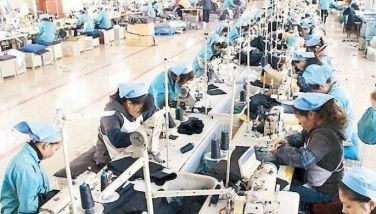Power failure

It’s like Nero fiddling while Rome was burning. The energy secretary was in Cebu playing politics while the Luzon grid was suffering power brownouts.
Assuring power supply stability is the energy secretary’s main responsibility. And he failed. Worst part is, the problem could have been predicted if DOE was doing its job.
Due to DOE negligence, it caught people by surprise. The inconvenience of a power failure during one of the hottest summers we have experienced made many angry at the Duterte administration.
Here is how my friend, Lito Madrasto, puts it in his Facebook post:
“Recurring brownouts in the NCR+? What’s going on? Electricity demand at this time is down! Schools are closed! Movie houses are closed! Majority of offices are closed! Most shops in malls are still closed! Majority of resorts are still closed!
“Restaurants are partially open! Even churches, mosques, and other places of worship are partially opened! Only hospitals are full! Only upper- and middle-class homes are using air conditioners!
“So why is there a power shortage?
“What’s going on?”
People working from home had a very unproductive day. Many are now being called to work at their offices because they have generators there. Never mind if they are in danger of catching COVID through central air conditioning systems not yet retrofitted to deal with aerosol infection of the virus.
During a recent hearing of the Joint Congressional Energy Commission, lawmakers repeatedly asked DOE officials if there would be brownouts or blackouts this June.
“Sa ngayon po wala tayong nakikitang high risk na magkakaroon tayo ng shortage,” Secretary Alfonso Cusi assured.
Mario Marasigan, director of the DOE’s Electric Power Industry Management Bureau, said Luzon is not expected to hit the peak demand of 11,841 megawatts. But he didn’t provide for forced plant outages.
Sen. Win Gatchalian complained in a tweet: “The committee was assured by the DOE that no brownouts will happen given that the country is in a delicate stage of its vaccine roll out. They should explain why their projections are off! They are the sole agency tasked to assure the public of the constant flow of electricity to homes.”
NGCP implemented a rotational supply interruption or manual load dropping (MLD) – the standard procedure during a red alert – starting at 1:11 pm last Monday. Supply was iffy this whole week and will be into next. Three large power plants are offline, contributing to the tight supply.
Sources in the power industry blame NGCP for the problem. They claim NGCP is not buying enough power for ancillary supply. NGCP’s total contingency reserve supply had been about 50 percent below what is required.
Last April 24, the energy department issued a press release pointing out that for the past two years, they have been reminding the NGCP of its obligation to provide sufficient levels of ancillary services (AS) or power reserves, as provided in a department circular.
DOE complained that “the NGCP is consistent on not complying with its responsibility with the firm contracting requirement. The NGCP has been dragging its feet by pursuing insufficient capacity and even opting an unreliable contracting of ‘non-firm’ AS Procurement Agreements (ASPAs),” Secretary Cusi said.
So, DOE ordered NGCP to renegotiate its existing non-firm contracts and comply with the 100 percent firm AS requirement. But as of December 2020, the NGCP’s level of firm contracted AS are still way below the mandated requirement as approved by the Energy Regulatory Commission.
It would seem, by ignoring the DOE order, NGCP is sacrificing grid stability for greater profits. Never mind that the company is already so profitable it is virtually printing money.
But why is DOE walking on eggshells and unable to enforce its orders? Are they worried about displeasing the Chinese minority equity holders in NGCP?
This gives power failure a new meaning: failure to use the power of government in the public interest. Why?
There is another problem begging to be addressed. Many of our large baseload power plants are about 30 years old. These were built as a reaction to the power crisis during the last years of the Cory administration.
Many of these old plants are also not being maintained as well as they ought to be. Perhaps it is a question of lack of incentives to spend on ageing plants. The result is forced outages and prolonged outages. One of the Sual coal fired plants is a good example.
With supply and demand balance at critical levels, we should be building new plants. Or how can we meet the demands of a tiger economy we are hoping will emerge from the ashes of this pandemic?
As it is now, stringent primary and secondary market price caps distort the market and discourage investment in dispatchable peaking capacity. In other countries, market price caps are a lot higher, resulting in real price signals for new investment.
Industry sources also tell me that there ought to be prioritization of ancillary reserves for grid stability. If AS requirements are fully served, the true condition of the demand/supply margin is seen way ahead and investments will follow.
“New investments are slow moving because you are beholden to the demands of the distribution utility and the energy commission. The acceleration of an energy forwards market can help build confidence for new investment.
“In simple terms… government controlling a little, ERC delaying, government not implementing reserve requirements… The usual…”
Of course, there are many things we want to do about our power supply. We want to have more renewable sources. We want competitive power pricing to make our industry regionally competitive. We want to protect the ordinary consumer.
But the big elephant in the room is: how much energy capacity do we need for the next 20 to 30 years and how will we be able to make that capacity available?
Given the time it takes to build a power plant, it will be too late to do anything soon enough. And we go through another power crisis, putting economic growth in jeopardy all over again. We can’t be that stupid. Or are we?
Boo Chanco’s e-mail address is bchanco@gmail.com. Follow him on Twitter @boochanco
- Latest
- Trending





























